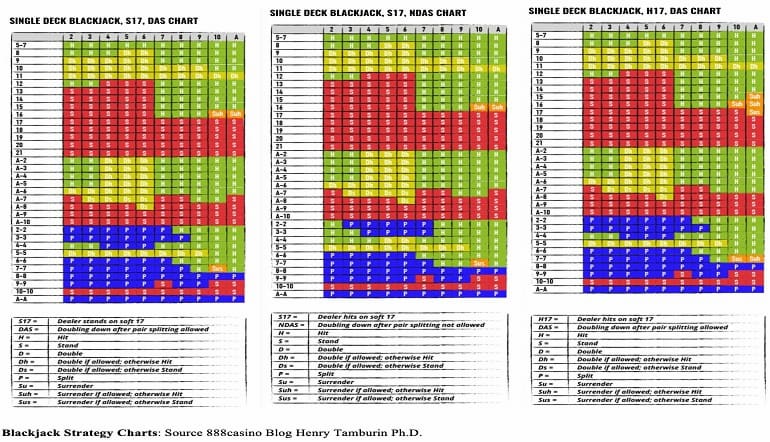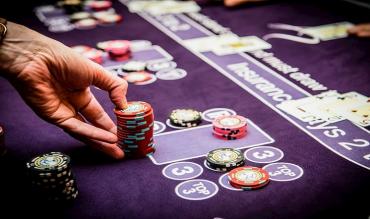The player is always first to act in blackjack and that is why it is a hard decision when to hit or stand in blackjack. Think about this for a second. The player must always risk drawing additional cards or standing on a hand total before the dealer is required to act.
Let's say you're dealt a Jack of diamonds and a 6 of hearts. That's a hand total of 16 and a pretty good hand at that. If the dealer’s upcard is a 10, should you risk drawing a card greater than 5? Or, should you simply stand on 16? It's an important decision that you're about to make.
Fortunately, the rules of blackjack game make decisions like this really easy. Blackjack strategy charts are used by players for precisely this purpose. First things first: check how many decks are being used in the blackjack game. Next, consult a blackjack strategy chart which makes accommodation for that number of decks.
Now, look on the left side of the strategy chart and move vertically (up or down) until you find your hand value. At a hand value of 16, you can either Stand or Hit, or Surrender if that action is allowed. You won't see Jacks, Queens, and Kings listed specifically, since they are 10-value cards. They will be listed under the 10-column to the right of the chart.
By running your right finger across the dealer’s side of the chart, and your left finger across the page representing your hand value, you will come to an intersection point. If the dealer hits on a soft 17, the correct action is to Surrender, or Hit when your blackjack hand value is 16.
If the dealer stands on a soft 17, the correct decision is to Surrender, or Hit. In a similar way, it is possible to determine the correct decisions for any player hand values in these casino games. For illustrative purposes, we have included a player hand value of 10, 14, and 19, with dealer upcard values of 10, 5, and Ace respectively.
• Player hand value 10, Dealer upcard 10 > Hit
• Player hand value 14, Dealer upcard 5 > Stand
• Player hand value 19, Dealer upcard Ace > Stand
Table of Contents
WHEN TO HIT ON 12?
If your hand value is 12, you will hit under the following circumstances:
> The dealer’s upcard is 2, 3, 7, 8, 9, 10 (including Jack-Queen-King), or Ace. It doesn't matter if the rules of blackjack state that the dealer stands on Soft 17, or the dealer hits on Soft 17.
SHOULD YOU HIT OR STAND ON 16?
If your hand value is 16, you will hit under the following circumstances:
> If the dealer’s upcard is 7 or 8, you will always hit. If the dealer’s upcard is 9, 10, or Ace and the option is available, you will surrender. Otherwise, you will always hit.
> If the dealer’s upcard is 2, 3, 4, 5, 6, you will always stand on 16.
The rules will change if you have a soft hand. In this case, you hit on a soft 16 when the dealer’s upcard is 2 or 3, 7, 8, 9, 10, Ace. When the dealer is showing 4, 5, or 6, you double, if permitted, otherwise hit.
SHOULD YOU HIT OR STAND ON 15?
If your hand value is 15, you will hit under the following conditions:
> The dealer’s upcard is 7, 8, 9, or Ace. If the dealer’s upcard is less than 7, you will stand. However, if the dealer’s upcard is a 10-value card, you will surrender (if available) when the dealer stands on soft 17, otherwise hit. If the dealer hits on soft 17, you will surrender (if available) when the dealer is holding a 10-value card, or an Ace. If no surrender option is available, you will simply hit.
The rules will change if you have a soft hand. In this case, you hit on a soft 15 when the dealer is showing 2, or 3, 7, 8, 9, 10, or Ace. When the dealer’s upcard is 4, 5, 6, you double, otherwise hit.
HIT OR STAND STRATEGY
In online blackjack, your decision to hit or stand is based on multiple factors. These include the dealer’s upcard (visible card), your blackjack card values, the number of decks in play, and the blackjack rules at the table. It is always best to consult a blackjack strategy chart for a definitive set of rules on when to hit or stand.
Remember to consider things like soft hand totals and hard hand totals in your decision-making process. There are plenty of different blackjack strategy charts to choose from, so be sure that the chart is aligned with the rules, format, and structure of your blackjack game.
WHAT BLACKJACK ‘HIT OR STAND’ CHART SHOULD YOU USE?

In terms of Hit or Stand decisions, the general rule of thumb with blackjack statistics is as follows:
• Always hit on a hard 11 or less (No Aces in the hand)
• When the dealer holds 4, 5, 6, stand on hard 12s, otherwise hit
• When the dealer shows 2, 3, 4, 5, or 6, stand on a hard 13, 14, 15, or 16, otherwise hit
• If you have a hard 17+, always stand
• If you have a soft 17 or weaker hand, always hit
• Always stand on a soft 18, except when the dealer has 9, 10, or Ace
• Always stand on soft hand values of 19+
Slight modifications will take place with different rules, but the above Hit or Stand decisions should hold you in good stead with your blackjack game.
You can read more about blackjack statistics here >>
HIT OR STAND BLACKJACK PRACTICE
Blackjack is entirely different to other online casino games. It's not like playing online baccarat which is simply a bet on the banker, the player, or a tie. It's not like slots where you simply place coins into a slot machine game and spin the reels for a chance to win.
Online blackjack is a skill-based game that requires players to practice tactics and strategies to perfection. It's not a perfect science, and even with basic blackjack strategy and blackjack charts, it is possible to lose against the dealer. In the long term however, hit or stand blackjack practice will certainly fine tune your game and reduce the number of losses you incur.
